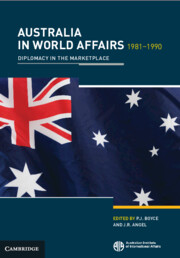Book contents
- Frontmatter
- Contents
- Preface
- Introduction
- Part 1 Australia and the World
- Part 2 Australia and the Regions
- 7 Australia and the United States
- 8 Australia and Southeast Asia
- 9 Australia and the South Pacific
- 10 Australia and the United Kingdom
- 11 Australia and Western Europe
- 12 Australia and the Eastern Bloc
- 13 Australia’s relations with Japan and the Korean Peninsula
- 14 Australia and China
- 15 The Commonwealth connection: a contemporary history and prospect
- Index
9 - Australia and the South Pacific
from Part 2 - Australia and the Regions
Published online by Cambridge University Press: 29 March 2024
- Frontmatter
- Contents
- Preface
- Introduction
- Part 1 Australia and the World
- Part 2 Australia and the Regions
- 7 Australia and the United States
- 8 Australia and Southeast Asia
- 9 Australia and the South Pacific
- 10 Australia and the United Kingdom
- 11 Australia and Western Europe
- 12 Australia and the Eastern Bloc
- 13 Australia’s relations with Japan and the Korean Peninsula
- 14 Australia and China
- 15 The Commonwealth connection: a contemporary history and prospect
- Index
Summary
The 1980s were a decade of fundamental change for Australia’s relations with the South Pacific. Australia began the decade with a clear desire to exercise regional leadership, an aspiration largely accepted by the Pacific Island countries and by larger powers with interests in the area. By the end of the decade, Australia’srole was being openly challenged by the leaders of the Pacific Island states. Inplace of the earlier acceptance of Australia’s approach was a widely shared view that it was overstepping the mark. Underlying the reported joking among Pacific Island delegates to the 1990 South Pacific Forum, that Australia should be demoted from full membership to the status of other larger powers – that of dialogue partner – lay a serious message: Australia was no longer to be seen as part of the region; rather it was to be viewed as an external power with fundamentally different values and interests. Australia’s relative importance in regional affairs was further diminished by the rising influence of larger powers such as France, the United States and Japan, which began to take an active interest in the area for the first time since the Second World War.
Keywords
- Type
- Chapter
- Information
- Australia in World Affairs 1981–1990Diplomacy in the Marketplace, pp. 167 - 197Publisher: Cambridge University PressFirst published in: 2024



